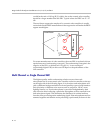
Designing Audio Conferencing Systems
B - 15
may occur in the data as it is transmitted through the network. It is not
uncommon for networks to require a hundred milliseconds or more to transfer
audio from one site to the other.
While the delay in the network will increase the perception of echoes, it does
not affect the performance of the acoustic echo canceller in either the local or
remote rooms. The acoustic echo canceller is concerned only with the audio as
it enters the room and reflected in the room and picked up again by the local
microphones. It doesn't matter to the echo canceller whether the signal from
the remote talkers takes 1 millisecond or 10 hours to be received - the local echo
canceller is only concerned with the audio once it reaches the acoustic echo
canceller and picked up by the local microphones. It is only the perception of
residual echoes that is influenced by the transmission delay. For instance an
echo that is heard with 5 msec of delay will not be objectionable at all, while
the same echo heard with 500 msec delay will render interactive
communications impossible.
Echo Return Loss
An echo canceller's performance is measured by how well it can reduce the
echo signal that is present at the microphone. The natural reduction of the echo
signal due to the physical separation of the loudspeakers from the
microphones is commonly referred to as echo return loss (ERL) and is
measured in dB. As shown in the following figure ERL is the ratio of 10
Log(A/B) where A is the signal that is sent to the loudspeaker amplifier, and
B is the signal picked up by the microphone. It is common for echo cancellers
to have a minimum required ERL for proper operation - exceeding the
required ERL will slow or prevent the acoustic echo canceller from properly
converging. Typical values for ERL are 0 - 10 dB with 0 dB characterizing a
more robust echo canceller than one that requires 10 dB of ERL for proper
operation.
While the ERL reduces the amount of echo present at the microphones, there
will still be a significant amount of echo that will be sent to the remote site if
there is no further processing on the signal. The enhancement of the echo
return loss due to the presence of an acoustic echo canceller is referred to as the
echo return loss enhancement or ERLE. In the following figure, the ERLE
AEC
Local Room
AEC
Remote Room
Delay Delay
Remote Room
Amp
Local Room
Amp


















